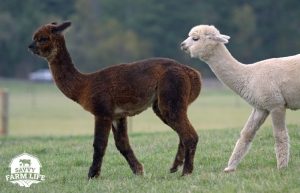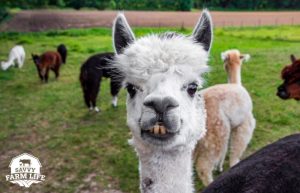
What You Need to Know About Caring For Alpacas
Are you thinking about getting an alpaca? It can be hard to find good information in the routine care and maintenance alpacas require. In this article, I’ll walk you through all the aspects you should know of when it comes to caring for alpacas.
How do you take care of an alpaca? Alpacas are relatively easy to care for, compared to other livestock. Here are some ways in which alpacas will need to be cared for:
- maintaining of a community setting with multiple alpacas
- access to fresh water and adequate pasture or hay
- a secure shelter and fencing to provide protection from elements and predators
- regular health maintenance including tonsil trimming, fleece shearing, vaccinating, and even teeth trimming.
- pasture and hygiene management
While alpacas may seem more rare compared to other small livestock animals, that doesn’t meant they are more difficult to care for. Read on to learn more about the specifics of alpaca care.
Alpaca Care: Can An Alpaca Live By Itself?
Before we get into the basic care of an alpaca, it is important to keep in mind that alpacas are herd animals, and it is not advised to have only one. The need for a community setting derives from the prey animal nature of an alpaca. By nature, alpacas are prey animals, meaning that they are designed to constantly be looking for danger or potential threats. A herd can help individual alpacas feel more protected and secure from potential threats. Multiple alpacas will also be able to watch out for each other and warn each other of potential danger.
It is a good idea to have at least three alpacas in order to establish a community setting for each of them. This will keep them happy and feeling safe. While you can keep alpacas in with other species of livestock like horses or sheep, they feel the most comfortable with their own kind. If you plan on raising an alpaca with other livestock, it’s best to raise them from a young age with the livestock animals they will be living with. This will help them bond more to the species.
Alpaca Care: How Much Space Does An Alpaca Need?
You will also need to ensure that your alpaca herd has sufficient space. Overcrowding can cause alpacas to become stressed and even aggressive. A good rule of thumb is you should not have no more than 8 – 10 alpacas per acre of land. Even then, you will need to follow adequate land and waste management in order to ensure that the alpacas have a clean space and access to adequate pasture or forage.
Alpaca Care: What Do I Need to Feed An Alpaca?
Alpacas are designed to have a diet largely consisting of pasture or hay. Their digestive system is designed to effectively extract sugars and protiens from vegetation. Their digestive system is also designed to be working constantly, and this is why you’ll see alpacas grazing for hours at a time. Pasture grass and hay can provide alpacas with the abundance of forage they need to keep their digestive systems happy.
Alpacas need access to either adequate pasture grass or quality hay to meet their nutritional requirements. Alpacas are efficient eaters, and eat around 1.5% – 2% of their body weight in forage (pasture or grass) each day. For a 125 pound alpaca, this equates to around 2 pounds of feed per day.
Pregnant and lactating dams (alpaca mothers) and alpacas with other health concerns may need more fodder or hay. Also, it is important to provide additional hay during the coldest months of the year – adequate body fat allows the alpacas to regulate their body temperature.
Depending on the season and the health of the individual alpaca, you may also choose to supplement your alpaca’s diet with commercially available feed. This is best discussed with your veterinarian to decide what the best diet for your alpaca herd is.
At this point, you may be wondering whether alpacas are hard to care for. To get an overview and to help you answer your question, visit my article Are Alpacas Hard to Care For? Alpaca Care Essential Guide.
Alpaca Care: How Much Water Does An Alpaca Need?
One alpaca need anywhere from 2-5 gallons of water a day. The amount of water the alpaca drinks each day will largely be determined by the water content in the grass and the weather and temperature. Not only do alpacas need water to stay hydrated, but their digestive systems are also highly dependent on water in order to work effectively. A dehydrated alpaca may have a hard time adequately digesting their food.
Alpacas can be picky about their water, and will need access to fresh, clean water at all times. If you look at the water and you would not drink it, it is likely your alpaca will not drink it either. One way to easily manage this requirement is to purchase an automatic waterer. These can be hooked up to a regular hose and secured to a fence post, providing constant access to fresh water as the water level lowers.
Alpaca Care: What Fencing Do I Need For Alpacas?
Some livestock animals are natural escape artists, and will challenge fencing that is not adequate. Alpacas do not challenge fences, instead remaining happy to adhere to these physical boundaries without testing them out too much. With that said, you will need to take into account the predators in your area to determine what type of fencing to erect. The best type of fencing for alpacas would be welded wire fencing that is at least four feet high. Welded wire creates a sufficient barrier that will keep predators out. You can also choose a welded wire fence with small enough gaps that an alpaca could not put its head through it.
Alpaca Care: What Type of Shelter Does An Alpaca Need?
 Alpacas, like all livestock, enjoy being outside as much as possible if the weather permits. They are also healthier living outdoors – the fresh air prevents them from some of the respiratory illnesses that can occur when living in an enclosed space. Alpacas do need to be provided with protection from extreme weather though, and typically a simple 3-sided, roofed structure will do the trick. Make sure to erect this structure so that it is not facing the wind.
Alpacas, like all livestock, enjoy being outside as much as possible if the weather permits. They are also healthier living outdoors – the fresh air prevents them from some of the respiratory illnesses that can occur when living in an enclosed space. Alpacas do need to be provided with protection from extreme weather though, and typically a simple 3-sided, roofed structure will do the trick. Make sure to erect this structure so that it is not facing the wind.
Alpacas are more tolerant to the cold than they are to the heat. While alpacas can withstand freezing temperatures, if you are expecting particularly cold weather you might fill the bottom of the shelter with straw or shavings, allowing the heat to stay in the shelter. If you are in a particularly hot and/or humid region, you will need to provide a way to keep your alpacas cool – this can be fans in the shelter to keep the air circulating, automatic sprinklers, or a portable misting system that easily attaches to the garden hose.
To learn more about shelters for alpacas, visit my article Do Alpacas Need Shelter? Alpaca Shelter Guide.
Alpaca Care: Manure and Waste Management
Alpacas are unique livestock in that they eliminate in the same 2 – 3 spots throughout the day. Some call these “communal piles”. While it is important to keep your alpaca’s shelter and pasture clean to prevent disease, this fact allows for a much easier clean up than with other animals.
Alpaca manure is excellent fertilizer and is gentle enough to be placed straight into the garden bed. This is another plus, as you will not need to maintain compost piles for a particular length of time before utilizing the manure. Some animals have “hot” manure and must be composted for 6-12 months before using – this is not the case with alpacas.
Alpaca Care: Toenail Trimming
Alpaca feet have two toes, and the toenails will need to be trimmed regularly unless they are worn down naturally in their environment. How often you trim your alpaca’s toenails will depend on the individual and the climate the alpacas live in. That being said, many keepers trim toenails every 4 weeks or so. To determine whether your alpaca’s toenails need a trimming, lift their feet and inspect the bottom – if the nails protrude past the pad of the foot, it is time for a trimming.
Alpaca Care: Shearing
Alpacas are prized for their luxurious fleece. This fleece will continue to grow, and if not sheared on an annual basis, will cause the alpaca to overheat. Extra fleece can also lead to skin conditions since the fleece can trap moisture to the skin of the alpaca.
Each year, you can expect to shear five to ten pounds of fleece off of each alpaca. You can do many things with this fleece, including selling it for profit! Most keepers choose to shear their alpacas in the Spring – this allows them the protection of this natural coat during the Winter, and provides relief during the warmer months. You may learn how to shear your alpaca yourself, or you can hire a professional to shear your alpacas for you.
Alpaca Care: Tooth Trimming
How often your alpaca will need his or her teeth trimmed will depend on their individual bite. If your alpaca has a proper bite, he may seldom need his teeth trimmed. However, if the front incisors protrude past the top gum line, you will need to trim them to keep your alpaca healthy and comfortable. In addition, male alpacas will develop fighting teeth in the back of their palates at maturity – these are often removed as they can cause injury to others during squabbles. You may learn how to trim your alpaca’s teeth yourself, or you can ask your veterinarian to perform this procedure.
Alpaca Care: Vaccinations and De-worming
Alpacas are typically healthy animals, but like all pets and livestock, may require regular vaccinations and de-worming. It is common to vaccinate your alpaca on an annual basis, and you may need to de-worm them monthly as well. A deadly parasite to alpacas is the meningeal worm – these are carried by white-tailed deer and can devastate the central nervous system. If you have white-tailed deer in your area, you can de-worm your alpacas monthly and also provide an annual vaccine. Many keepers also vaccinate against rabies and CDT on an annual basis as well. It will be valuable for you to have a trusted veterinarian who is familiar with caring for alpacas. It is also a great idea to connect with other alpaca keepers and breeders in your area to see the common healthcare they follow. Alpacas in Arizona may not face the same health concerns as alpacas in North Carolina, so it is important to find out what is necessary for your alpaca’s health in your specific region.
Alpacas, The Low-Maintenance Livestock
In addition to their beautiful coats and their gentle demeanors, alpacas are loved because they are relatively easy to care for. Though they are low-maintenance in terms of care, you will still need to ensure that you can meet all of their needs before making the commitment of bringing your own herd home.
To learn more about alpacas, visit my article Alpaca Behavior Guide: Alpaca Behaviors And What They Mean.
